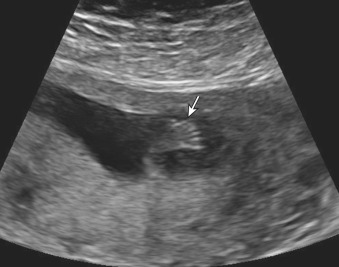Abstract
In this chapter, we review the diagnosis and underlying potential causes for isolated clubfoot (Talipes Equinovarus). Prenatal ultrasound (US) findings in particular are described, along with accompanying images to augment the reader’s understanding.
Keywords
clubfoot, talipes equinovarus, talipes, clubfeet
Introduction
Talipes equinovarus (clubfoot) is an abnormality of the foot position. It may be positional, congenital (isolated), or part of a syndrome. Clubfoot resulting from in utero positional forces, as may occur with prolonged severe oligohydramnios, multiple gestation, or breech presentation, is not a “true” clubfoot in that the deformity can usually be corrected by manual manipulation of the foot.
Disease
Definition
Clubfoot is a foot malformation in which the foot is fixed in a plantar-flexed position, and the sole is rotated inward. The deformity may be unilateral or bilateral and affects the bony, muscular, and ligamentous structures. Manual manipulation of the extremity does not correct the defect.
Prevalence and Epidemiology
Clubfoot occurs in approximately 1 : 1000 to 3 : 1000 pregnancies and is more common in males (2 : 1 male-to-female ratio). Frequency varies by ethnicity; it appears to be less common in Asians (0.5 : 1000) and more common in Polynesians and in the Maoris of New Zealand (6 : 1000 to 7 : 1000).
Etiology and Pathophysiology
Most cases of clubfoot are isolated and idiopathic in nature and are not associated with other structural or genetic abnormalities. Clubfoot is commonly classified according to intrinsic or extrinsic causes. Intrinsic causes of clubfoot include genetic disorders, neuromuscular diseases, and other syndromes ( Table 64.1 ). Extrinsic causes are external forces that deform an otherwise normally developing foot ( Table 64.2 ). This chapter focuses on intrinsic causes of clubfoot.
| CHROMOSOME ABNORMALITIES |
|
| GENETIC SYNDROMES |
|
| SKELETAL DYSPLASIA |
|
| NEUROMUSCULAR DISORDERS |
|
| NEUROLOGIC ABNORMALITIES |
|
|
Manifestations of Disease
Clinical Presentation
Prenatal ultrasound (US) can identify 80% of cases of clubfoot, as early as the late first trimester. Approximately 30% to 60% of cases are bilateral. In unilateral cases, the defect is more likely to be right-sided. The likelihood of an underlying chromosome abnormality is low (1.7%–3.6%) if clubfoot is isolated, although reports have found that 4% to 19% of fetuses will have anomalies detected later in pregnancy or at birth. Many karyotypic abnormalities associated with clubfoot are of the sex chromosomes (i.e., 47XXY) and are not related to maternal age. Unilateral versus bilateral clubfoot does not affect the risk of chromosomal abnormality. The addition of microarray studies may increase the yield of invasive prenatal testing, although the complex inheritance patterns of clubfoot suggest that it rarely occurs due to a single gene mutation.
Imaging Technique and Findings
Ultrasound.
Prenatal diagnosis is confirmed if the plantar surface of the foot is persistently visualized in the same plane as the tibia and fibula. Clubfoot can be identified in the first ( Fig. 64.1 ) or second ( Fig. 64.2 ) trimester. Three-dimensional or four-dimensional US is useful in the evaluation of fetuses with skeletal abnormalities, especially for imaging of the extremities ( Figs. 64.3 and 64.4 ).











